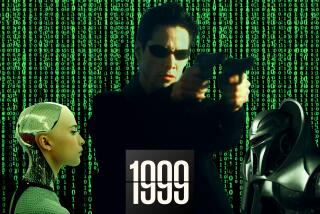Second-class aliens
- Share via
Set in South Africa in the not too distant past, the riveting “District 9” begins nearly three decades after a monstrous spaceship lost power over Johannesburg. There it sits still, suspended over the city like a giant metal thundercloud.
These are stormy days indeed inside District 9, the refugee camp just outside the city built to deal with the huge alien population left stranded by the broken craft. It’s one of those “separate but equal” shantytowns reeking of garbage and growing dissatisfaction among the Prawns, which is as good a slur as any for a race of creatures who look like tall, two-legged cockroach/lobsters on steroids.
“District 9” is very smart sci-fi, but that’s just the beginning; it’s also a scathing social satire hidden inside a terrific action thriller teeming with gross aliens and regrettable inter-species conflict. And it’s a blast. . . .
Unemployment is rampant in District 9, healthcare is nonexistent -- unless you count those secret scientific experiments -- and crime is on the rise, helped along by a Nigerian mafia that specializes in guns and ammo. The Prawns spend their days brawling and getting drunk on cat food, which it turns out they have a serious weakness for, sending cat food prices soaring. The locals are fed up and pushing for segregation, again, in South Africa. Don’t we ever learn?
Meanwhile, the Prawns just want to go home. They still don’t speak English, and humans don’t understand much of their synthesized screeches, so what we have here is a failure to communicate (though subtitles help us out).
The film opens on a drab, workstation-filled floor in what turns out to be headquarters for MNU, the organization well compensated by the world for managing the aliens. A mass resettlement of District 9 is about to get underway, with news cameras rolling and talking heads covering every bit of minutia.
Director Neill Blomkamp, who wrote the screenplay with Terri Tatchell, uses the 24-hour news cycle and its panel of experts to fill out the film’s complex back story in a form that feels frighteningly familiar. But as with everything else about “District 9,” there’s more to it than that.
At the center of our story is a pocket-protector MNU middle manager named Wikus Van De Merwe, played by Sharlto Copley, well known in South African film and television circles. He’s an unlikely hero, with the demeanor of a ‘50s-era science teacher in a short-sleeve white shirt and horn rims (in a very loose way the film has a 1950s feel). Wikus has been picked to oversee the resettlement project in part because he’s an ordinary Joe who the higher-ups think will play well on TV, with its live news feed transmitting his every move.
But like a reality TV show gone terribly wrong (or right), bad things begin to happen once Wikus steps inside the district, with a series of accidents and events turning him into a wanted man.
You can feel his pain as he realizes that the company he’s spent a lifetime working for has abandoned him when he needs it most.
A great deal of action and insight accompanies Wikus as he tries to evade authorities and the medical teams who are suddenly quite interested in his alien exposure. He finds allies where he least expects them, among the Prawns, specifically a strategic leader named Christopher Johnson (Jason Cope) and his young prawn spawn, little C.J., who is bright, funny and created completely by special effects, so they say.
Despite the language barriers, understanding grows and, not surprisingly, Wikus begins to see another side of things, aliens driven by needs not unlike his own.
Violence of varying stripes runs through the film, and within the bloody mess some very nifty camera work is going on. As bullets penetrate flesh or crack shell, the camera shifts, throwing you right in the middle of things, the pieces raining down around you.
It’s like nothing I’ve experienced, and if they’d gone 3-D with it, I’d have probably run for cover.
The action sequences are aggressive and extensive. The metal eco-skeletons that the aliens can slip into and the assault rifles they pick up are theirs exclusively because the machines respond only to alien DNA.
The choice to make the aliens particularly gross is an intriguing one. No ethereal eyes to peer into, no close encounters desired, given the rows of nasty-looking pincers on their bellies. It’s a lot to get past on the road to tolerance.
Humor, and there is that too, comes in the form of irony. But then Blomkamp has seeded irony and analogies throughout “District 9” as he makes his way through a myriad of modern anxieties including the racial divide, class differences, big business, broadcast news and the big-brother world of reality TV.
One of the many themes Blomkamp kicks around is the numbing effect of the endless loop of information and analysis on cable news. By moving between narratives -- the world view created by the news reports and Wikus’ unfolding reality -- the filmmaker has created a secondary horror story. Not a new idea, just particularly chilling in its execution here.
In many ways, “District 9” echoes the cautionary tales of such sci-fi classics as “The Day the Earth Stood Still.” Others will see a more direct predecessor in 1988’s “Alien Nation,” but it turns out to be just a shadow of “District 9.”
Though the themes are universal, the director’s childhood in South Africa clearly informs the film’s sensibility, in this case greatly adding to its distinctive look and feel. It’s an impressive first feature for the 29-year-old Blomkamp.
In a good summer, there’s usually a movie that will come out of nowhere and completely wow us. This is a good summer, and that movie is “District 9.”
--
--
‘District 9’
MPAA rating: R for bloody violence and pervasive language
Running time: 1 hour, 53 minutes
Playing: In general release
More to Read
Only good movies
Get the Indie Focus newsletter, Mark Olsen's weekly guide to the world of cinema.
You may occasionally receive promotional content from the Los Angeles Times.








